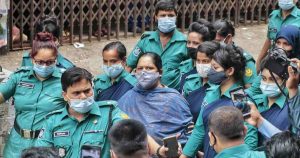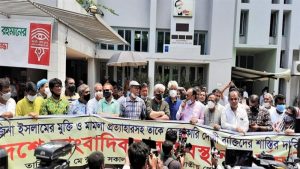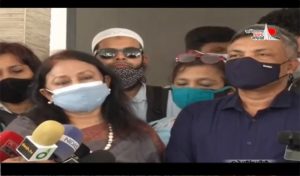State Minister for Foreign Affairs M Shahriar Alam on Thursday urged the experienced journalists of the mainstream traditional media to help ensure smooth transformation into digital media where the future of journalism lies.
“Many mainstream media outlets (print) have failed to realise the true potential of digital media contributing to the rise in so-called online media portals which don’t create news values rather create problems,” he said amid a lively discussion and debate whether the days for newspapers are over.
Commonwealth Journalists Association (CJA), Bangladesh chapter and CJA India Chapter jointly organised the discussion, titled ‘Indo Bangla Conference on Digital Media: Threats and Prospects’, at the Jatiya Press Club.
Jatiya Press Club president Shafiqur Rahman, Indian delegation members led by CJA Global President Mohendra Ved also spoke at the discussion moderated by Secretary General, CJA Bangladesh Shyamal Dutta.
President of Bangladesh Association of Software and Information Services (BASIS) Mustafa Jabbar made a presentation on the prospect and challenges of digital media in Bangladesh.
The Sate Minister, however, recognised that few newspapers like The Daily Prothom Alo and others managed to handle the transformation process relatively better.
Talking about the challenges of digital journalism, he said the word ‘digital’, to a large extent, represents youths. “But we see, sometimes, lack of responsibility and experiences apart from their positive sides.”
The State Minister felt the necessity of a supportive role from the mainstream media people to ensure accuracy, quality and main core values and ethics of journalism in the digital media.
“It’s true in this transformation the mainstream media are losing the ground at a faster pace at different levels and demographic locations,” Shahriar Alam observed.
He also shared his bad experience when he became the victim of fake news during his tour of Boston, USA a couple of years back as one of the media outlets reported that he had a “confidential meeting with a BNP leader and stayed overnight at his house.”
“Things can be really sensitive and difficult. That’s why we need a consensus on how we can avoid such a situation,” he said adding that though the editor of media outlet was kind enough not to print it on its print version by the time it was shared by many on social media platforms, including screenshots.
The State Minister said the government is willing to help the media move fast in its journey towards digitisation but mentioned that the government cannot do things alone and sought a responsible role from all in society.
Former resident editor of The Times of India Kingshuk Nag said, “Today, I don’t read newspapers in the morning. I have been an editor for 17-18 years. I used to read five newspapers daily. Today, this is not an exaggeration. I really don’t read newspapers today.”
Explaining the reason, he said he gets everything instantly online and many news feeds come through Facebook. “My wife keeps complaining why I get engaged with Facebook all the time.”
The prominent journalist, who recently launched his own news portal, said digital age has made newspapers redundant. “Digital media means traditional media is finished. Owners (of newspapers) are saying – We’re sunset industry. We can’t survive.”
Jayanta Roy Chowdhury, currently Senior Editor-Business with The Telegraph, highlighted the role of digital media in India.
He said in the process India’s traditional media, especially in UP’s case, were left high and dry in their utter lack of understanding of which way the wind was blowing.
The journalist said the case was atypical of the power of social media as well as of its limitations.
The reach of social media has best been defined by well-known Indian chip designer Saibal Dutt as `the power of word of mouth combined with visuals but circulated at infinitely high speeds.’
Jayanta Roy said Facebook, twitter, whatsapp circulated messages to India’s millions which television and print woke up far too late.
He mentioned that Indian Prime Minister Narendra Modi, it is believed, has told his party members to increasingly use social media to reach out to voters as the party prepares for the 2019 general elections. India’s finance minister now uses facebook and twitter to break news.
Jayanta Roy, however, said undoubtedly the survival and resuscitation of media as “we know it will depend on how proactive editors are and how independently newsrooms function.”
Channel-i-Online Editor Zahid Newaz Khan said some 80-82 percent of their news readers come through social media platforms, including Facebook, where their news are shared. “We need to make the best use of technology and, I hope, authentic journalism will prevail, not the bad, dirty or motivated journalism,” he said.
Khan said the flow of multimedia content will keep growing in the days to come and laid emphasis on ‘news literacy’ among children so that they grow up with the sense to judge which one he or she will follow.
“A news item of siphoning off money is read by 112 readers while news on film star Shakib Khan by 800. It’s a matter of audience’s taste. You can’t control it. So, you need to generate juicy and lucid news items for readers (without compromising accuracy and quality) apart from serious stories,” the journalist said sharing the trend of readers’ interest.
Senior journalists, columnists from Bangladesh and India who participated in the discussion laid emphasis on check and counter-check to avoid the danger of fake news.
Some argued that the days for newspapers are not over yet and its presence will remain relevant, at least for the next 10 years.
source:UNB




